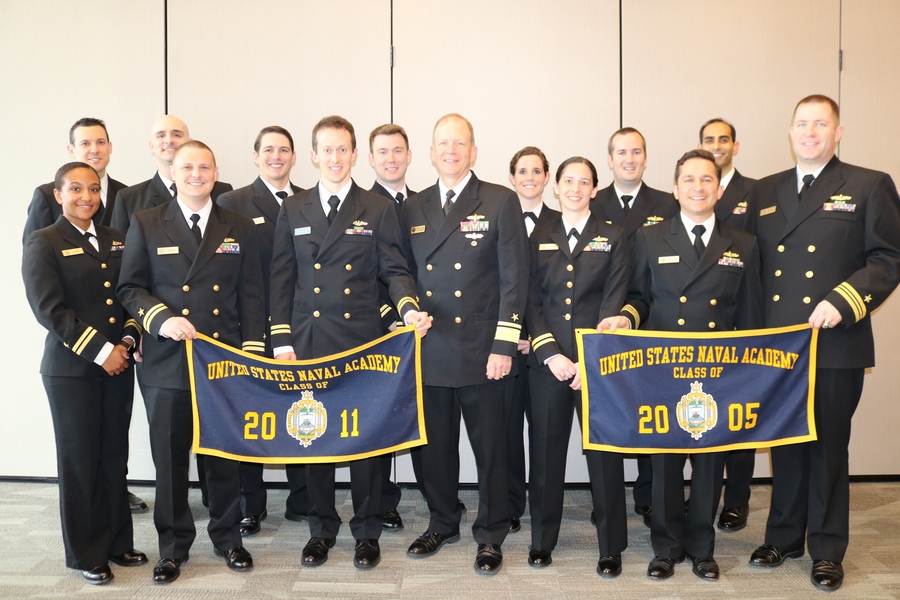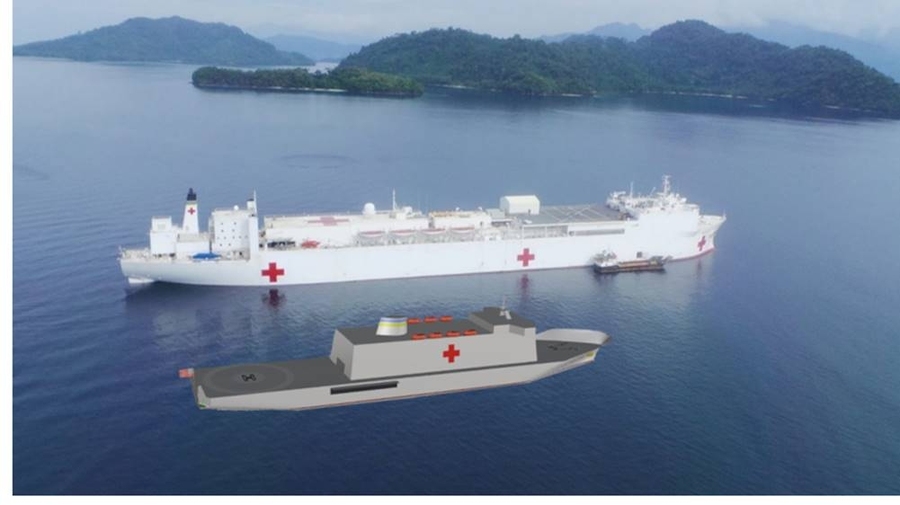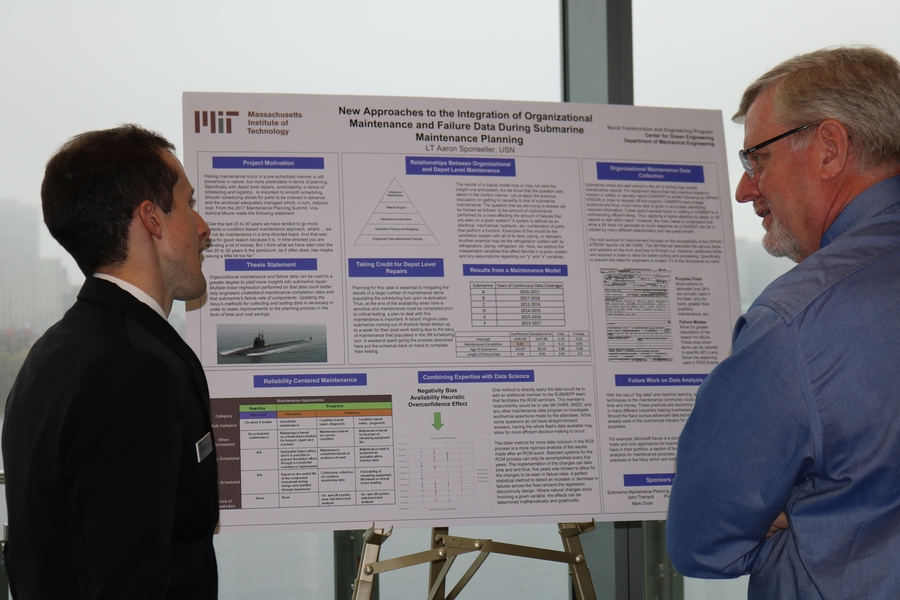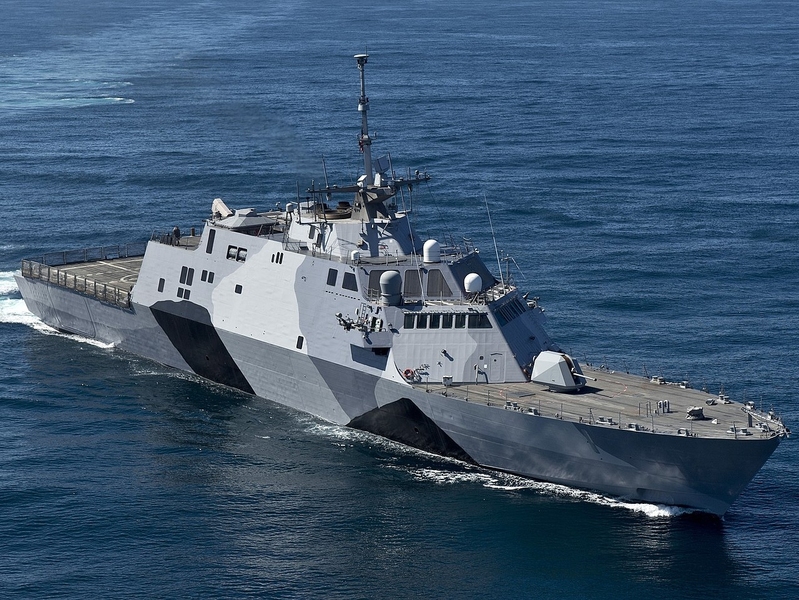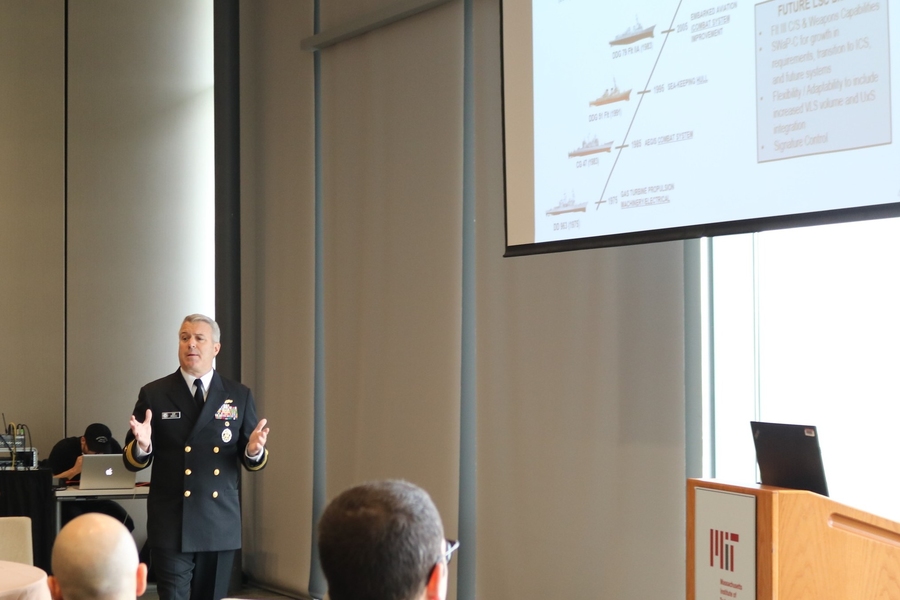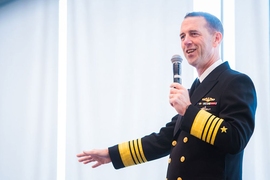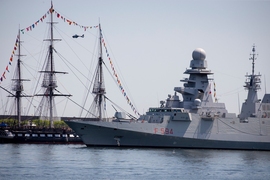For the past 20 years, officials from the U.S. Navy and leaders in the shipbuilding industry have convened on MIT’s campus each spring for the MIT Ship Design and Technology Symposium. The daylong event is a platform to update industry and military leaders on the latest groundbreaking research in naval construction and engineering being conducted at MIT.
The main event of the symposium was the design project presentations given by Course 2N (Naval Construction and Engineering) graduate students. These projects serve as a capstone of their three-year curriculum.
This year, recent graduate Andrew Freeman MEng '19, SM '19, who was advised by Dick K. P. Yue, the Philip J. Solondz Professor of Engineering, and William Taft MEng '19, SM '19, who works with James Kirtley, professor of electrical engineering and computer science, presented their current research. Rear Admiral Ronald A. Boxall, director of surface warfare at the U.S. Navy, served as keynote speaker at the event, which took place in May.
“The Ship Design and Technology Symposium gives students in the 2N program the opportunity to present ship and submarine design and conversions, as well as thesis research, to the leaders of the U.S. Navy and design teams from industry,” explains Joe Harbour, professor of the practice of naval construction at MIT. “Through the formal presentation and poster sessions, the naval and industrial leaders can better understand opportunities to improve designs and design processes.”
Since 1901, the Course 2N program has been educating active-duty officers in the Navy and U.S. Coast Guard, in addition to foreign naval officers. This year, eight groups of 2N students presented design or conversion project briefs to an audience of experts in the Samberg Conference Center.
The following three projects exemplify the ways in which these students are adapting existing naval designs and creating novel designs that can help increase the capabilities and efficiency of naval vessels.
The next generation of hospital ships
The Navy has a fleet of hospital ships ready for any major combat situations that might arise. These floating hospitals allow doctors to care for large numbers of casualties, perform operations, stabilize patients, and help transfer patients to other medical facilities.
Lately, these ships have been instrumental in response efforts during major disasters — such as the recent hurricanes in the Caribbean. The ships also provide an opportunity for doctors to train local medical professionals in developing countries.
The Navy's current fleet of hospital ships is aging. Designed in the 1980s, these ships require an update to complement the way naval operations are conducted in modern times. As such, the U.S. Navy is looking to launch the next fleet of hospital ships in 2035.
A team of Course 2N students including Aaron Sponseller, Travis Rapp, and Robert Carelli was tasked with assessing current hospital ship designs and proposing a design for the next generation of hospital ships.
“We looked at several different hull form sizes that could achieve the goals of our sponsors, and assigned scores to rank their attributes and determine which one could best achieve their intended mission,” explains Carelli.
In addition to visiting the USS Mercy, a hospital ship that was commissioned during World War II, the team toured nearby Tufts Medical Center to get a sense of what a state-of-the-art medical facility looked like. One thing that immediately struck the team was how different the electrical needs of a modern-day medical facility are from the needs nearly 40 years ago, when the medical ships were first being designed.
“Part of the problem with the current ships is they scaled their electrical capacity with older equipment from the 1980s in mind,” adds Rapp. This capacity doesn’t account for the increased electrical burden of digital CT scans, high-tech medical devices, and communication suites.
The current ships have a separate propulsion plant and electrical generation plant. The team found that combining the two would increase the ship’s electrical capacity, especially while "on station" — a term used when a ship maintains its position in the water.
“These ships spend a lot of time on station while doctors operate on patients,” explains Carelli. “By using the same system for propelling and electrical generation, you have a lot more capacity for these medical operations when it’s on station and for speed when the ship is moving.”
The team also recommended that the ship be downsized and tailored to treat intensive care cases rather than having such large stable patient areas. “We trimmed the fat, so to speak, and are moving the ship toward what really delivers value — intensive care capability for combat operations,” says Rapp.
The team hopes their project will inform the decisions the Navy makes when they do replace large hospital ships in 2035. “The Navy goes through multiple iterations of defining how they want their next ship to be designed and we are one small step in that process,” adds Sponseller.
Autonomous fishing vessels
Over the past few decades, advances in artificial intelligence and sensory hardware have led to increasingly sophisticated unmanned vehicles in the water. Sleek autonomous underwater vehicles operate below the water’s surface. Rather than work on these complex and often expensive machines, Course 2N students Jason Barker, David Baxter, and Brian Stanfield assessed the possibility of using something far more commonplace for their design project: fishing vessels.
“We were charged with looking at the possibility of going into a port, acquiring a low-end vessel like a fishing boat, and making that boat an autonomous machine for various missions,” explains Barker.
With such a broad scope, Barker and his teammates set some parameters to guide their research. They honed in on one fishing boat in particular: a 44 four-drum seiner.
The next step was determining how such a vessel could be outfitted with sensors to carry out a range of missions including measuring marine life, monitoring marine traffic in a given area, carrying out intelligence, surveillance and reconnaissance (ISR) missions, and, perhaps most importantly, conducting search and rescue operations.
The team estimated that the cost of transforming an everyday fishing boat into an autonomous vehicle would be roughly $2 million — substantially lower than building a new autonomous vehicle. The relatively low cost could make this an appealing exercise in areas where piracy is a potential concern. “Because the price of entry is so low, it’s not as risky as using a capital asset in these areas,” Barker explains.
The low price could also lead to a number of such autonomous vehicles in a given area. “You could put out a lot of these vessels,” adds Barker. “With the advances of swarm technologies you could create a network or grid of autonomous boats.”
Increasing endurance and efficiency in Freedom-class ships
For Course 2N student Charles Hasenbank, working on a conversion project for the engineering plant of Freedom-class ships was a natural fit. As a lieutenant in the U.S. Navy, Hasenbank served on the USS Freedom.
Freedom-class ships can reach upwards of 40 knots, 10 knots faster than most combat ships. “To get those extra knots requires a substantial amount of power,” explains Hasenbank. This power is generated by two diesel engines and two gas turbines that are also used to power large aircraft like the Dreamliner.
For their new frigate program, the Navy is looking to achieve a maximum speed of 30 knots, making the extra power provided by these engines unnecessary. The endurance range of these new frigates, however, would be higher than what the current Freedom-class ships allow. As such, Hasenbank and his fellow students Tikhon Ruggles and Cody White were tasked with exploring alternate forms of propulsion.
The team had five driving criteria in determining how to best convert the ships’ power system — minimize weight changes, increase efficiency, maintain or decrease acquisition costs, increase simplicity, and improve fleet commonality.
“The current design is a very capable platform, but the efficiencies aren’t there because speed was a driving factor,” explains Hasenbank.
When redesigning the engineering plant, the team landed on the use of four propellers, which would maintain the amount of draft currently experienced by these ships. To accommodate this change, the structure of the stern would need to be altered.
By removing a step currently in the stern design, the team made an unexpected discovery. Above 12 knots, their stern design would decrease hull resistance. “Something we didn’t initially expect was we improved efficiency and gained endurance through decreasing the hull resistance,” adds Hasenbank. “That was a nice surprise along the way.”
The team’s new design would be able to meet the 30 knot speed requirement of the new frigate program and it would add anywhere between 500 and 1,000 nautical miles of endurance to the ship.
Along with the other design projects presented at the MIT Ship Design and Technology Symposium, the work conducted by Hasenbank and his team could inform important decisions the U.S. Navy has to make in the coming years as it looks to update and modernize its fleet.
